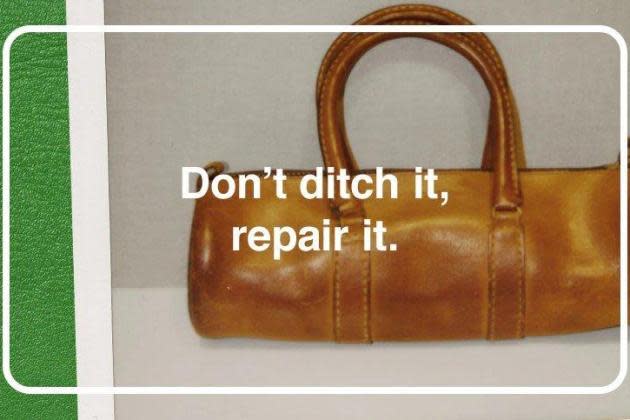Coach Reveals How Much Product It Actually Destroys After Damaged Goods TikTok

While some activists opt for edgy banners at a runway show, others opt for “unboxing” videos of damaged goods in front of sustainable fashion TikTok’s unflinching gaze.
Over the past few days, Coach bags have found themselves at the top of fashion’s growing trash pile — and this on the heels of Tapestry Inc.’s net-zero commitment.
More from WWD
In a now-viral TikTok from New York City-based influencer and waste consultant Anna Sacks (known as the “trash walker”), Sacks “unboxes” a haul of damaged Coach goods she purchased from a Texas-based dumpster diver, saying she intends to take them in for a repair.
“As you can see, they’re all slashed, which is Coach’s policy. This is what they do with unwanted merchandise. They order an employee to deliberately slash it so no one can use it. Then they write it off as a tax write-off, under the same tax loophole as if it were accidentally destroyed,” Sacks says in the TikTok.
Joon Silverstein, the global head of sustainability and digital at Coach, held firm over the phone amid questions from WWD.
“First, reducing waste is one of the most important strategies,” Silverstein said. “When it comes to damaged or defective product, we have been working on many avenues….It’s unfortunate these posts came out now, because we had been doing this thoughtfully.”
The brand operates four pillars, including restored, vintage, up-crafted and remade “intended to address products at any stage of end-of-life,” per Silverstein, within its long-running Repair Workshop and relatively new (Re)Loved program which launched in April. Options are also being explored to capture waste left over from those repair activities, the company said.
Regarding the (Re)Loved product drops, Silverstein said: “Our customer response has been absolutely amazing…Each of the drops have sold out in a matter of days if not hours.”
Even prior to (Re)Loved, Silverstein said some 115,000 products have been repaired and returned to customers in North America over the past three years. Today, there are 15 pilot stores that operate (Re)Loved programs. In exchange for their pre-loved goods to be recycled or reimagined, customers receive credit between $10 and $140 depending on item value/condition. Coach’s website says its repair service is “currently accepting 100 percent leather bags (Coach Retail only) in very good or gently worn leather condition, with minimal scratches and wrinkles.”
“We are working to recycle and repair products in any condition,” Silverstein said.
Coach confirmed it will be expanding this program to an additional 16 stores by the end of the month. And by January or February, Silverstein said the brand will complete its (Re)Loved rollout to all retail stores.
According to research conducted by Columbia University’s Center for Sustainable Futures, more than 85 percent of unwanted clothes and bags end up in landfills. Coach maintains it is working “to change that,” alongside its customer.
That much is true — as the brand has leather goods warranties, skilled leather craftspeople and circular-minded programs (such as its (Re)Loved program) in place for its customers — it just hasn’t solved all the internal kinks.
While Coach, admittedly, does not have a zero-tolerance policy on landfilling, the catchall claim that all of its 939 global stores are engaging in what Sacks called “deliberate” destruction is untrue. According to Silverstein, the amount of product destroyed by stores represents less than 1 percent of the brand’s global sales. “Over 40 percent of our retail stores have stopped damaging product,” added Silverstein, saying the lack of scale infrastructure dents its aims.
Is there a world where no fashion products are sent to landfill, or in this case, the dumpster? Not yet — but no amount of destruction will likely be acceptable where increasingly conscious consumers are concerned and where more reasonable alternatives exist.
Some responsible designers and recycling innovators are still finding broader relevance with the latest social controversy. Patrick McDowell, a designer known for reimagining inventory from the likes of Swarovski and Burberry, believes the issue speaks to the broader “overproduction problem in fashion.”
“The simple fact [is] that we produce too much because the whole industry is based on guessing what people want to buy,” said McDowell, championing turning the “slashed pieces into a special capsule collection — while furthering their sustainability efforts into reducing production levels and crucially reassessing how their clients consume Coach.” McDowell said he approached Coach earlier this year about a reimagined collection but nothing materialized.
Brooklyn-based zero-waste designer of the eponymous Zero Waste Daniel label, Daniel Silverstein also weighed in. “The goals of a company that is that large and publicly traded and has the overall mission of selling apparel and accessories for a profit — it’s hard to shift that mission,” Silverstein said. “Changing the relationship with the customer is the important thing.…Everybody has that need for repair, but until it’s something that’s [not] just adopted but is actually trendy to do — it’s really only there as a Band-Aid or fixture to show there’s an effort.”
If there’s one other outlying benefit of the story’s virality, it may be the heightened urgency for finding scaled means for recycling.
To that end, Scott Kuhlman, chief executive officer of recycling platform ReCircled, said: “Many damages of handbags need to simply be cleaned and repaired.” Where that isn’t feasible, Kuhlman believes putting resources toward patent-pending solutions — where a bag can be ground down and “recycled into new leather” — is a desperate, industry-wide need.
Sign up for WWD's Newsletter. For the latest news, follow us on Twitter, Facebook, and Instagram.
